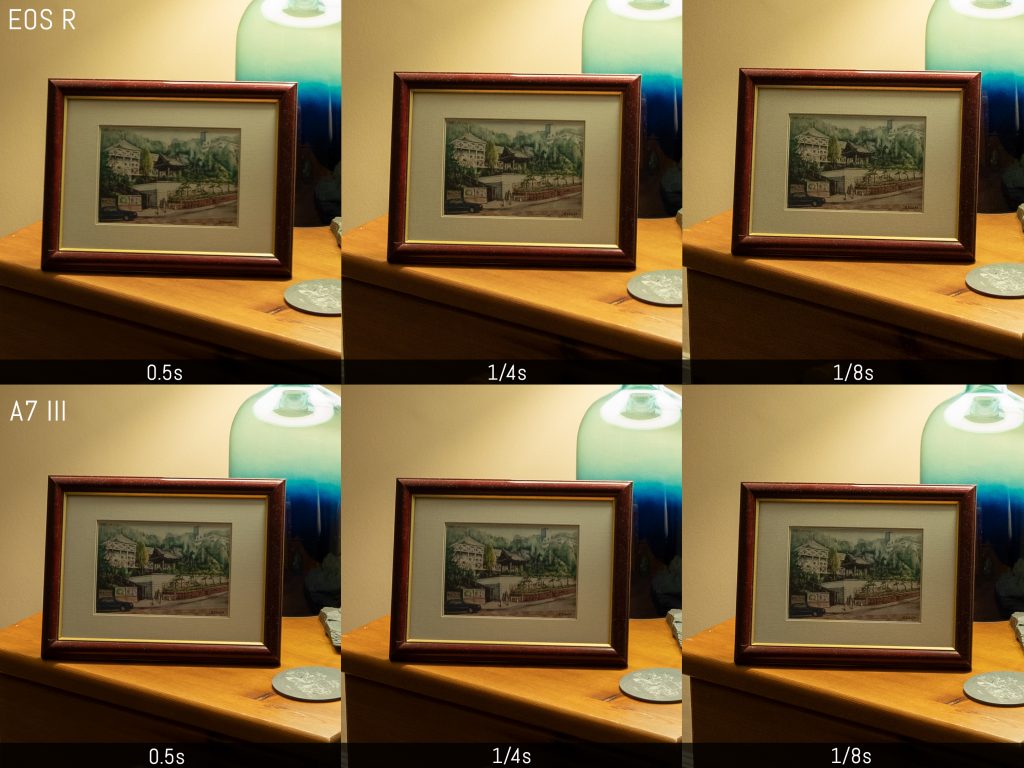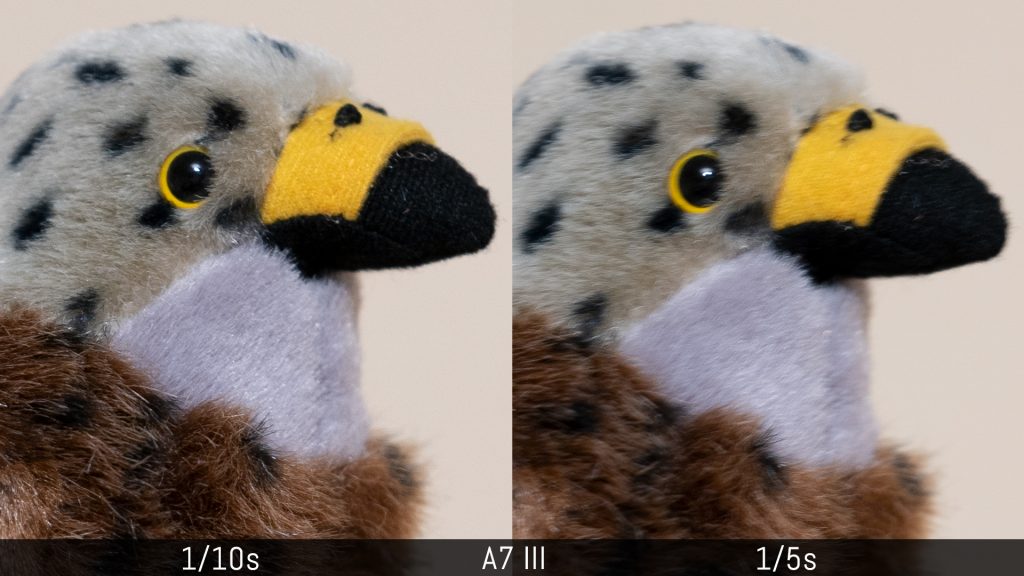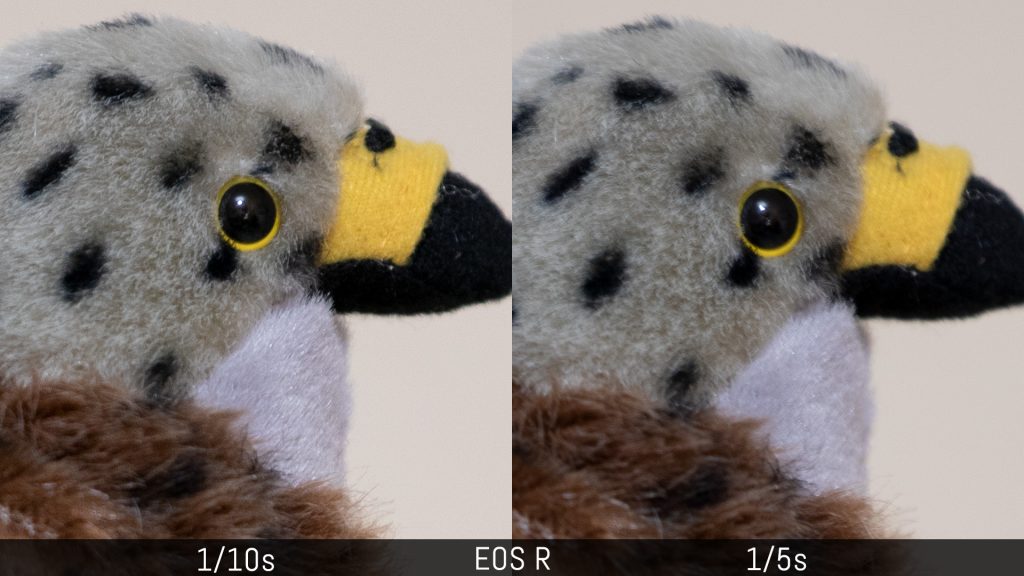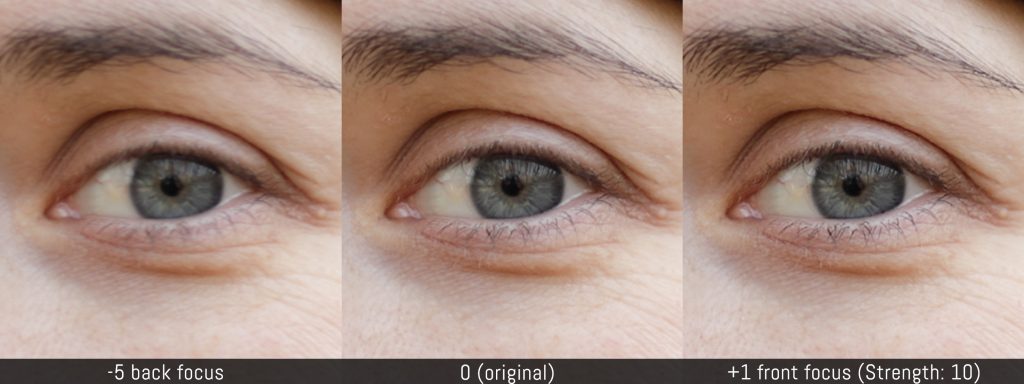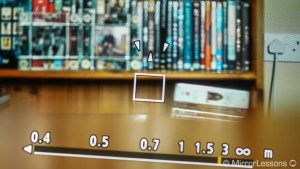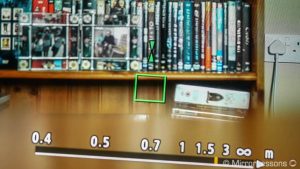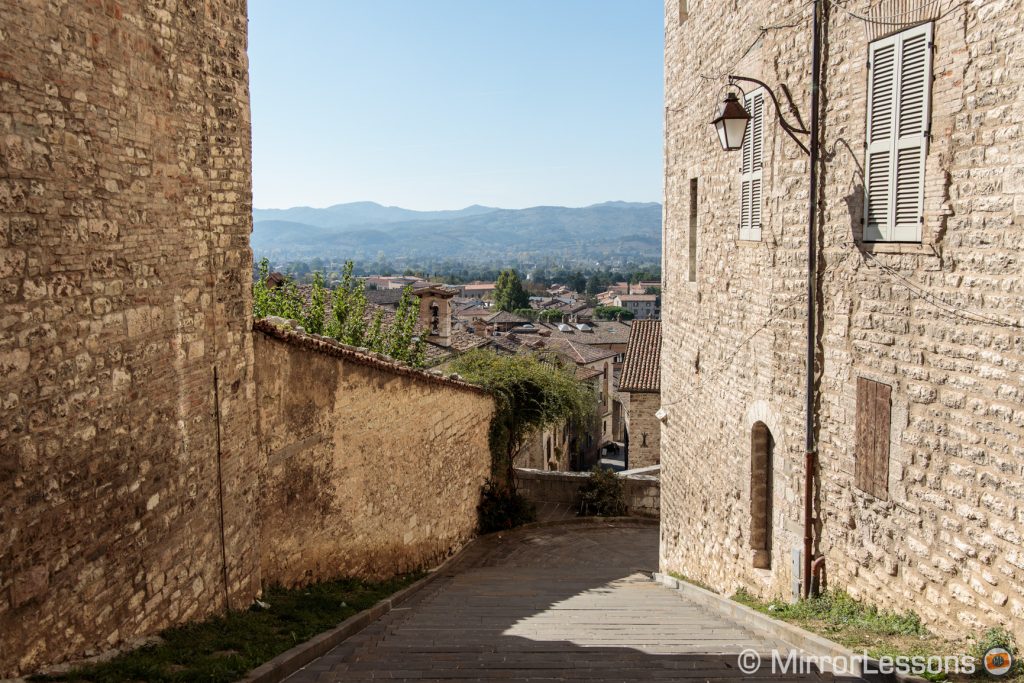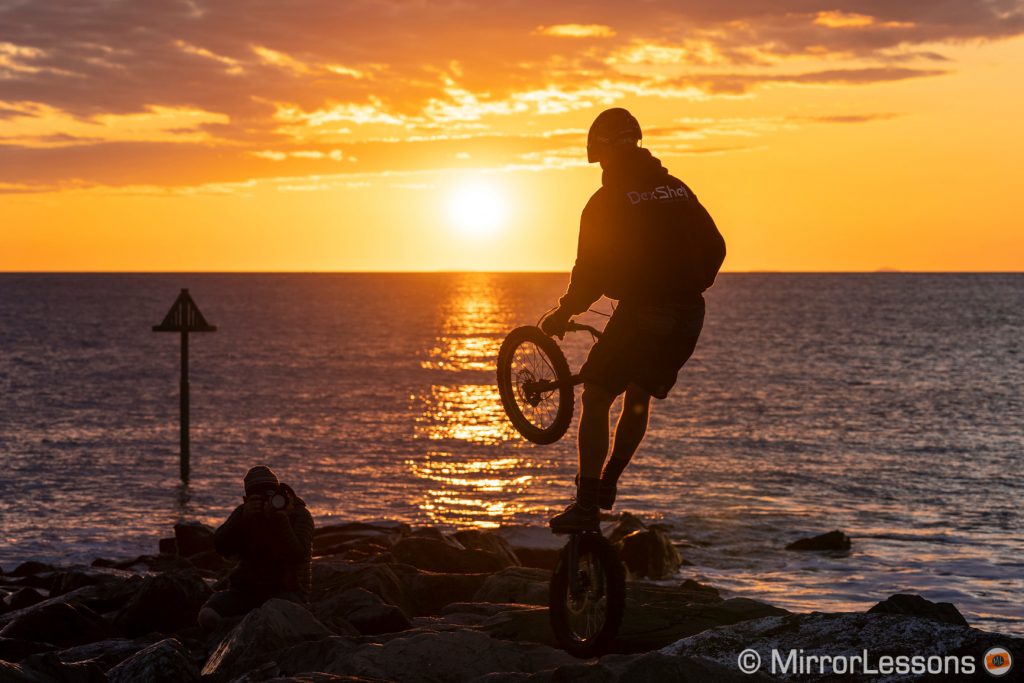You are now on page 4. Here we talk about the differences in terms of image stabilisation, video and other topics before wrapping up:
- Page 1: design and functionality
- Page 2: image quality (stills)
- Page 3: autofocus and speed
- You are on age 4: image stabilisation, video, other features and conclusion
Table of Contents – Page 4
1. Image stabilisation
2. Video capabilities
3. Flash and extra features
4. Battery life
5. Lenses and mount system
6. Price
7. Conclusion
8. Additional images and coverage
Image stabilisation
The EOS R lacks in-body stabilisation so you have to rely on lenses with optical stabilisation or external supports.
The A7 III on the other hand comes with 5-axis stabilisation, which gives you a significant advantage with lenses that lack optical stabilisation. It works with adapted lenses (3 axes only if there aren’t any electronic contacts) which means that no matter which lens you use, the camera will always provide some degree of stabilisation for stills and video.
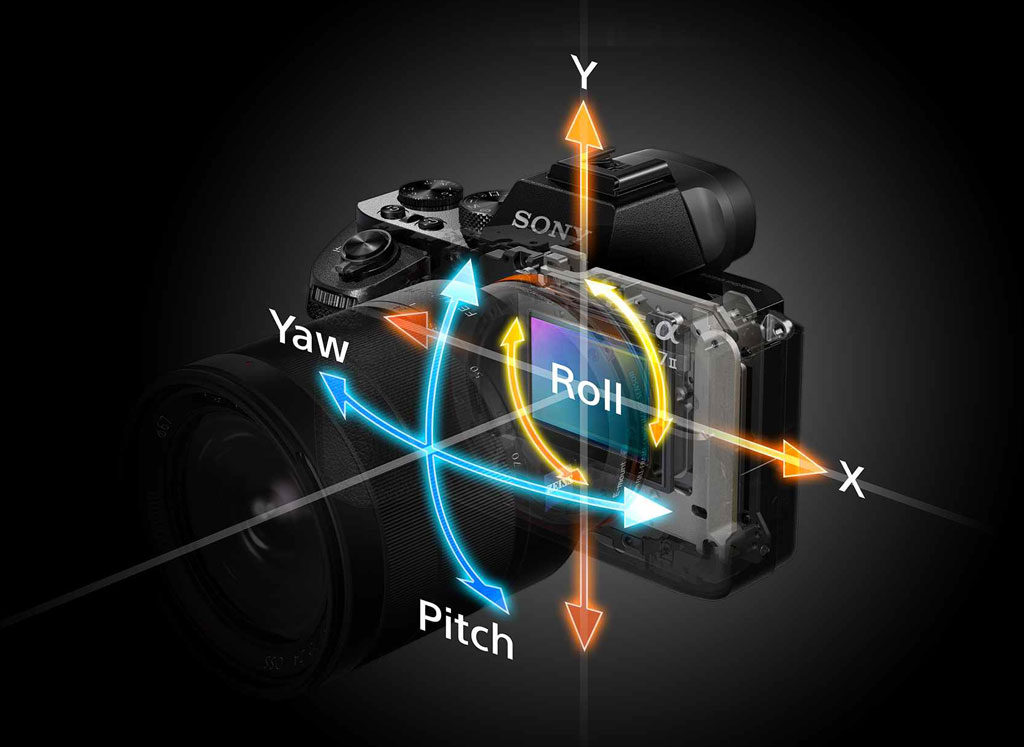
For this specific comparison, I was curious to what advantage the A7 III sensor shift would bring compared to optical stabilisation.
First I compared the IS of the Canon RF 24-105mm and the sensor stabilisation of the Sony (using the FE 35mm f/2.8 ZA).
The A7 III gave me a better keeper rate at half a second, whereas I only got one sharp shot (out of 10) with the EOS R. The difference is more or less the same at 1/4s. Only at 1/8s do we see an improvement from the Canon.
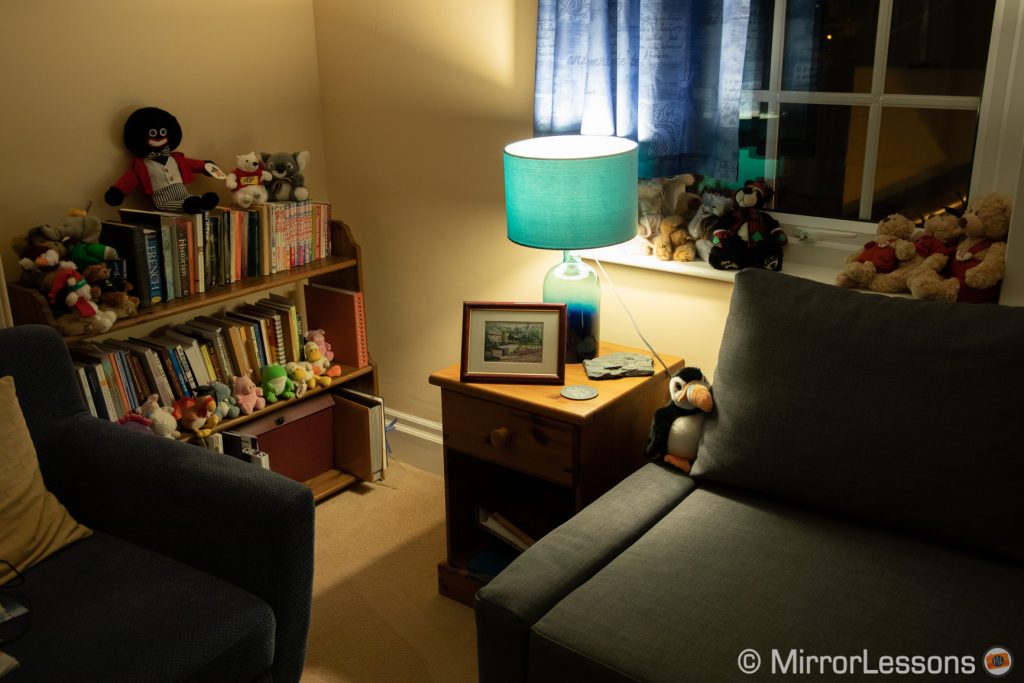
The A7 III can combine 3 axes on the sensor with optical stabilisation (2 axes). With the 70-200mm f/2.8 G Master, I got good results at 1/10s but the keeper rate improved from 1/20s. Below 1/10s, none of my images were sharp.
With the EOS R and the 70-200mm f2.8 L IS USM III (plus adapter), the results are more or less the same but I would say that the Sony retains a slight advantage at around 1/10s.
Of course the performance will vary depending on the specific lens you use and how effective its OIS is. Also remember that the shutter speeds shown in this test are extreme and the keeper rate is poor. I found that a safe shutter speed with wide angle lenses was 1/10s, or between 1/20s and 1/30s with telephoto lenses.
The Sony IBIS is compatible with Movie mode and works in the same way. The EOS R can add software stabilisation in addition to the IS of the lens. See the next chapter for more feedback.
Video capabilities
The Canon EOS R and Sony A7 mark III can record 4K video up to 30p, but there are some significant differences to talk about.
You can check out our direct comparison video below and read on for the written analysis.
The EOS R gives you more choice when it comes to bitrates. With the All-intra compression, it goes up to 480Mbps whereas with the IPB file it records at 120Mbps. The A7 III uses a more modest 100Mbps by comparison.
The first annoying thing about the Canon is that it performs a heavy 1.8x crop on the sensor when recording 4K. This means that you need to use very wide full-frame lenses, or APS-C lenses to maintain a decent wide angle shot. The Sony has a 1.5x crop mode (APS-C), but can record using the full width of the sensor with the same quality (full pixel readout with no pixel binning).
The A7 III does better in terms of sharpness, especially when comparing the APS-C and full-frame modes. It can reproduce finer details especially when using the Picture Profiles with an increased detail level. The difference isn’t huge but it is noticeable. It is also important to remember that certain Canon profiles (including C-Log) are noticeably softer in comparison to the Standard or Vivid profiles. You can add some sharpening in post with good results.
The differences in colour reproduction are similar to those we analysed for stills. The A7 III produces redder tones overall, and it is easier to notice when colour grading the Log profiles. In addition to the Creative Styles used for stills, the Sony has 10 Picture Profiles that you can customise with various settings (gamma, colour phase, saturation etc.).
For skin tones, the Canon has a more neutral rendering that shifts a little towards a magenta tint depending on the profile selected. The Sony displays more yellow and orange tones but also appears warmer as a result. When grading the Canon C-Log however, I find it easier to get a warm and smooth result than with the Sony.
The EOS R has more dynamic range in the highlights if we compare it to the Creative Style profiles of the A7 III. The latter retains more information in the shadows when using the Picture Profiles. When the Log curves are selected, the Sony recovers more colour information in the highlights and produces far less noise in the shadows.
The A7 III wins hands down at high ISOs. The EOS R already exhibits more noise from ISO 1600 and gets progressively worse at every full stop increase, whereas the Sony does really well up to 12800 ISO, where noise is very contained. Even at the highest values (ISO 51200, 102400) it remains decent despite the increased noise, whereas the EOS R looks pathetic.
Unlike the Sony, you can use noise reduction on the Canon. Setting it to Normal does smooth out the footage a little, but the quality remains inferior.
The Canon suffers more from rolling shutter when moving slowly and when panning quickly. The Sony does a bit better in S35 mode than in full-frame mode.
The Canon surprised in terms of its image stabilisation. It doesn’t feature anything in-body but can add digital stabilisation on top of optical stabilisation when recording video. You can choose between two modes (Enable and Enhanced) and it was more stable than the A7 III for static and panning shots. The Sony on the other hand produces some annoying jitters which is more visible while panning than for static shots.
When walking with the camera, the results are more similar, although at times I find the EOS R a bit smoother. Note than when digital stabilisation is enabled, the field of view is further reduced.
Continuous autofocus is fast on both cameras and you can tweak the sensitivity via dedicated settings in the menu. With face detection, I find the A7 III a bit more stable, whereas the Canon can sometimes be a bit slower to react and correct focus. You can use the AF settings and the touch screen to perform slow transitions between two focus points, but the EOS R’s slowest setting is still faster than that of the A7 III.
In 1080p, the A7 III can record up to 120fps with sound or via the Quick&Slow mode to produce slow motion results that get recorded to your SD card. You need to go down to 720p on the EOS R to have the same possibility, and the quality is much worse.
The footage in 1080p is not as sharp as 4K of course, but the EOS R performs better overall, especially when using the Movie Cropping mode (same 1.8x as 4K).
Both cameras can switch between PAL and NTSC, but on the Sony you need to change cards, otherwise it will ask you to format it.
The two models have a mic input and headphone output to record and monitor audio.
One nice setting found on the EOS R is the possibility to change the aperture in 1/8 steps for better exposure accuracy.
Flash and extra features
The maximum sync speed of the EOS R is 1/200s, which is slightly slower than the A7 III (1/250s).
The two cameras share a few specifications like TTL, ±3Ev flash compensation, bracketing, slow sync and rear sync. Neither has a built-in flash but each brand offers a wide variety of speedlight units that can work in High Speed Sync and Wireless modes. Many options from third-party brands are also available.
As for extra features, the EOS R has a mode called Dual Pixel RAW (also present on the 5D mark IV DSLR). The camera takes advantage of the Dual Pixel CMOS AF technology to record a special RAW file that contains the depth information read by the phase detection points. When you open the file in Canon’s Digital Photo Professional software, you can make tiny adjustments such as fine-tuning the focus point.

There is very little room for correction with this feature. The example above shows you how far you can push focus backward. (I only needed an extra step forward to make the eye perfectly sharp.) For other images where the camera focused on the wrong eye, there wasn’t enough leeway to correct it. I guess the extreme shallow depth of field in this case doesn’t help. Ideally I can imagine this feature working well for studio portraits with more controlled depth of field.
You can also make small changes to the flare and shift the bokeh left or right but it doesn’t always work well. In the second example below, shifting left/right makes the bokeh look less pleasant in my opinion.
The EOS R has other features that the A7 III doesn’t offer, including:
- Multiple exposure: you can merge 2 to 9 frames with live preview on the screen, as well as choose the blending method (additive, average, bright or dark)
- RAW processing: convert RAW files into JPGs by changing exposure, white balance and other settings
- Time-lapse Movie: you can record frames at a set interval and create a video time-lapse in camera (4K or 1080p output)
The two cameras have a number of things in common such as:
- Exposure and White Balance Bracketing
- select and rename a folder
- add copyright information to the exif data
- tethering to a computer (USB for both, WiFi for the EOS R.
Speaking of WiFi, you can transfer images to a mobile device, or remotely control the cameras from your smartphone with the dedicated apps. The Canon app allows you to switch between the stills and video modes directly, whereas with the Sony you have to turn the dial on the camera.
Both products offer magnification and peaking to help you focus manually. An advantage of the Canon is that magnification doesn’t reduce the resolution in video mode as it does on the Sony when recording 4K.
The EOS R has an additional MF assist that has rapidly become my favourite: Focus Guide. Thanks to the Dual Pixel CMOS AF technology, the camera provides a visual guide to show you in which direction and how much you need to adjust focus. If eye detection is enabled, it will automatically show you the adjustment for any eye detected. When the image is in focus, the guide turns green. It is very precise and reliable, and definitely the best MF assist I’ve ever used.
In playback mode, the EOS R gives you a few extra options including the possibility to crop or resize your images, delete both RAW and JPG files, or delete one of the two file types.
Finally, I close this chapter with a rather unusual feature of the EOS R: when the camera is turned off, the front mechanical curtain closes to protect the sensor when you change lenses. I find it funny that in nearly 10 years of mirrorless evolution, no other brand has ever thought of this. One possible reason is that dust could get stuck on the blades of the shutter mechanism, which is rather delicate. I guess only time will tell if this idea is going to backfire or not. For now, I rather like it.

Battery life
The EOS R is rated at 370 shots per cycle, which is not impressive when put next to the 650 frames attributed to the A7 III.
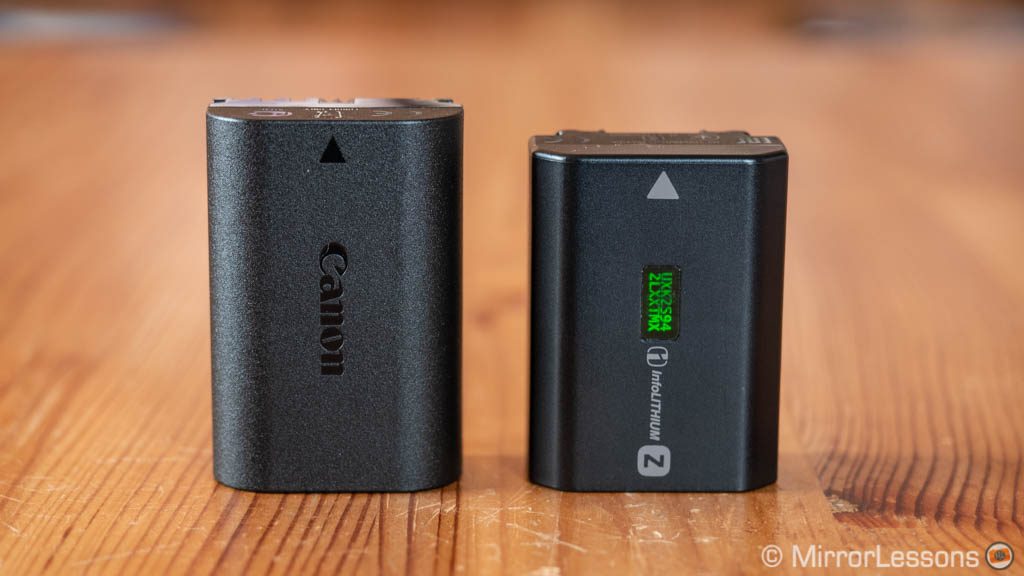
Of course these are official figures, and in real life I found the Canon to be a good performer. When recording video, I was surprised to see that the battery life percentage didn’t drop any faster than the Sony. Overall though, the A7 III still has the edge, especially for long days of shooting with continuous AF and intense burst sequences.
The EOS R has an Eco mode to boost the endurance. It also gives you more information concerning the remaining capacity of the battery, and if you register all your units, you get a usage history log.
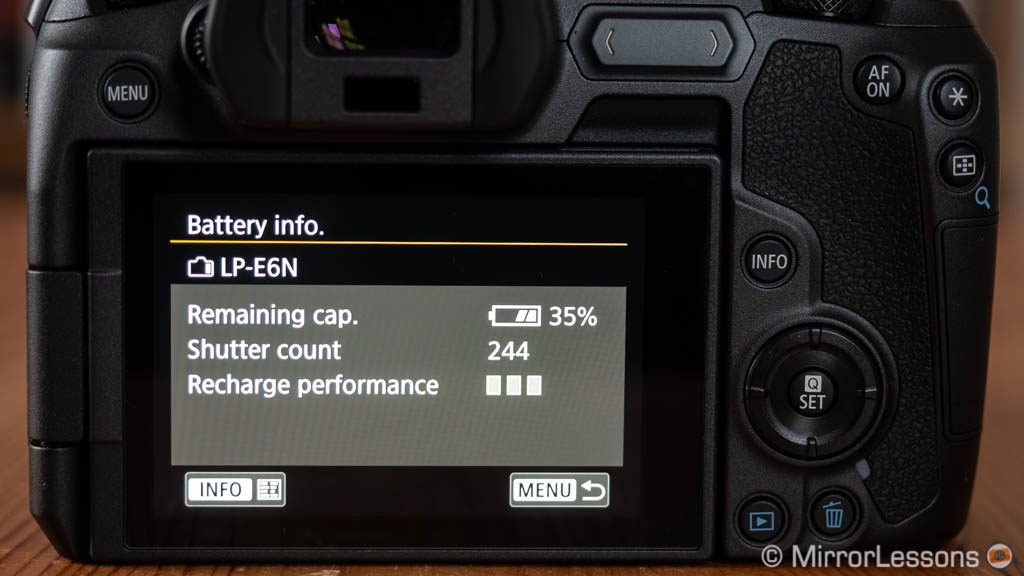
Both batteries can be charged via USB by connecting the camera to computer or mobile charger bank. Note that only the Canon LP-E6N type can be charged in camera, not the LP-E6N.
A battery grip is available for both cameras (Canon BG-E22 and Sony VG-C3EM). There are third-party options for the A7 III as well.
Lenses and mount system
The EOS R is the start of a new system for Canon, but it’s not their first mirrorless series. The EOS M range uses an APS-C sensor and a smaller mount. Canon decided not to make its two mirrorless systems compatible. The new RF mount is larger than the M mount and therefore you won’t be able to use a RF lens on a EOS M camera, and vice versa.
Sony has taken a different approach. Although it too started with an APS-C series, it has kept the same E-mount for its full-frame system, so any E-mount lens can be used with either format. This is undeniably an advantage if you work with these two formats.
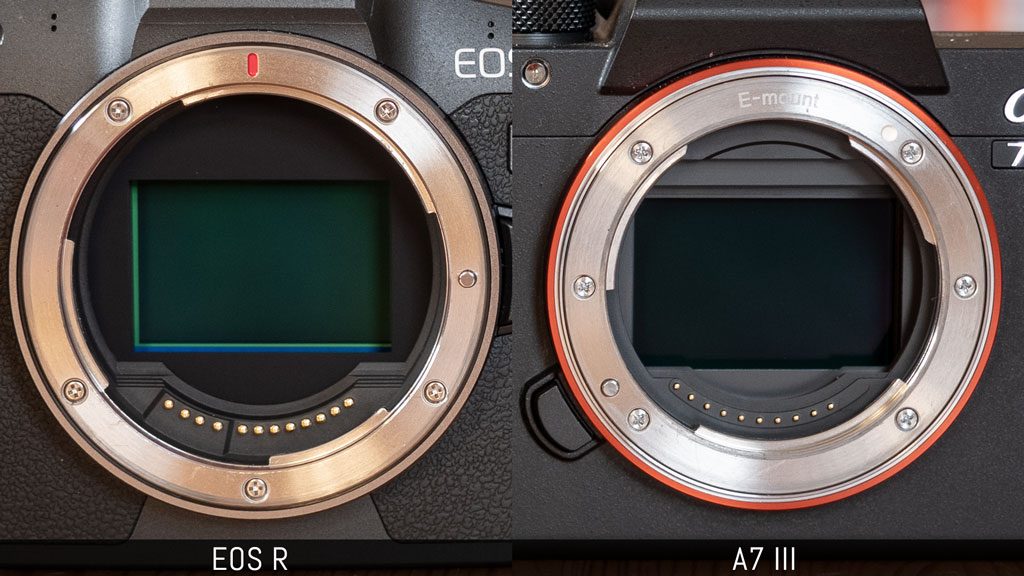
The RF mount is larger than the E-mount as you can see from the picture above. According to Canon, the large size coupled with the short flange distance will allow them to build a new generation of high performing lenses. The new RF 50mm f1.2, for example, is one of the best prime lenses I’ve ever tested. There are also three other lenses as of now: a 24-105mm f4 IS, a 35mm f1.8 IS Macro and a surprising 28-70mm f2.
The Sony E-mount system has been around for longer and today offers an excellent selection of zooms and primes. There are also many third-party manufacturers that have started designing lenses for the E-mount including Samyang, Zeiss, Sigma and Tamron. And to be fair to Sony, despite the presumed limitation of the smaller mount, I’ve tested some spectacular E-mount lenses too.
Canon hasn’t released a lens roadmap yet, but in the meantime, you can use one of three RF to EF adapters from the brand and mount Canon DSLR lenses, which work well on the new camera.
Of course you can use many Canon lenses on the A7 III too because Sony shared its mount specifications with third-parties years ago. This means you can find several adapters that allow you to use autofocus. Although there are some limitations, these adapters certainly made life easier for photographers transitioning from one system to another or wanting to use two different systems.
Price
The EOS R can be found for around $1800 / £1900 / €2100
The A7 III is being sold at $2000 / £1750 / €2000.
Note: prices as of March 2020. They can vary depending on special offers and instant rebates. In euro (€) countries, the EOS R is sold in a bundle with the RF-EF adapter.
Conclusion
If I look at the Canon EOS R purely from a design perspective, I could easily label it as one my favourite mirrorless cameras of the year. I love the grip, the ergonomics, the ease of use, the menu system and the interface. The M-Fn touch bar is a bit weird at first but has more potential than a traditional dial. The viewfinder is bright and sharp, and the touch screen is responsive and precise. It’s really a shame that Canon wasn’t able to make it perfect by adding a dual card slot and an AF joystick. They were so close!
If I look at the quality and performance however, it’s a very different story. The Sony A7 III has a clear advantage when it comes to dynamic range and high ISO performance, with the latter being even more evident when recording video. 4K is also less of a frustration since you can use the entire width of the sensor, unlike the EOS R which crops by a heavy 1.8x.
The Canon has lots of potential when it comes to autofocus, and its face and eye detection might be the closest to the class-leading Sony, but the lack of consistency and the disappointing continuous shooting speeds make the EOS R rather limited for sports and wildlife.
The truth is, there is very little the A7 III can’t do. Granted, the design has room for improvement, but if I add 5-axis stabilisation, dual SD card slots, the longer battery life and lower price to the list, it becomes easy to see why Sony is the better deal.
The EOS R feels like a baby step in the right direction. There is a lot of potential but Canon needs to up its game because the competition, not only from Sony but also Nikon and soon Panasonic, is fierce.
As a closing thought: I believe that a camera with the design and ease of use of the EOS R (plus a joystick and a dual SD card slot) and the technology of the A7 III (stabilisation, speed, sensor) would be close to perfection. With things being as they are now, I feel that Sony can get there faster but who knows – Canon might have some surprises in store. Either way, I look forward to seeing both systems evolve for the better.
Strengths of the Canon EOS R:
- excellent design and ergonomics
- very comfortable grip
- large and detailed EVF
- multi-angle LCD monitor
- responsive and complete touch screen interface
- easy and straight-forward to use
- fast autofocus for stills and video
- Focus Guide MF assist mode is class-leading
- effective digital stabilisation in video mode
- 480Mpbs internal and 10-bit 4:2:2 via HDMI
- a bit more generous with extra features
Strengths of the Sony A7 III:
- more dynamic range with the RAW files
- better high ISO performance for stills and video
- faster continuous shooting speeds (with and without C-AF)
- eye detection for humans and animals
- in-body 5-axis stabilisation
- no sensor crop when recording video
- contained rolling shutter in movie mode
- 120fps in 1080p
- two SD card slots
- better battery life
- less expensive
To consider:
- The EOS R autofocus is one of the best in its class but lacked some consistency in performance and accuracy in my tests
- The A7 III ergonomics aren’t the best but a grip extender can improve comfort
Choose the Canon EOS R if:
- you prioritise comfort and ease of use over everything else
- you own Canon DSLR lenses and want better autofocus performance when using them
Choose the Sony A7 III if:
- you want better photo and video quality
- you’re interested in shooting sports and wildlife
Check the price of the Canon EOS R on:
Amazon | Amazon UK | B&H Photo | eBay
Check price of the Sony A7 III on:
Amazon | Amazon UK | B&H Photo | eBay
Second-hand Canon cameras on
Second-hand Sony cameras on
Additional images and coverage
If you want to see more sample images taken with these two cameras, you can click on the links below where you’ll also find original files (RAW and JPGs) to download:
You can also check out the following comparisons:
Navigation:
- Page 1: design and functionality
- Page 2: image quality (stills)
- Page 3: autofocus and speed
- You are on page 4: image stabilisation, video, other features and conclusion

